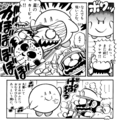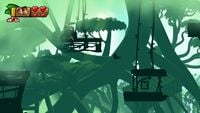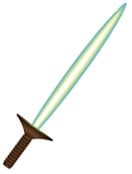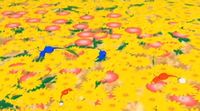List of references and parodies: Difference between revisions
| Line 42: | Line 42: | ||
**Iggy Koopa is named after Iggy Pop, lead singer of American rock band The Stooges.<ref name="Dayvv Interview"></ref> | **Iggy Koopa is named after Iggy Pop, lead singer of American rock band The Stooges.<ref name="Dayvv Interview"></ref> | ||
**Roy Koopa is named after early American rock musician Roy Orbison, since they both wore glasses.<ref name="Dayvv Interview"></ref> | **Roy Koopa is named after early American rock musician Roy Orbison, since they both wore glasses.<ref name="Dayvv Interview"></ref> | ||
**Lemmy Koopa is named after Lemmy Klimister, lead singer of British rock band Motorhead.<ref name="Dayvv Interview"></ref> | **Lemmy Koopa is named after Lemmy Klimister, late lead singer of British rock band Motorhead.<ref name="Dayvv Interview"></ref> | ||
**Ludwig von Koopa is named after composer Ludwig von Beethoven, due to their hairstyle.<ref name="Dayvv Interview"></ref> | **Ludwig von Koopa is named after composer Ludwig von Beethoven, due to their hairstyle.<ref name="Dayvv Interview"></ref> | ||
Revision as of 15:40, April 30, 2016
The following is a list of references to other media, popular culture, or real life subjects that has appeared in the Mario series. Note that references to other Mario games are not included here, nor are references in crossover games referring to the source material.
References
Mario Bros. series
Mario Bros.
- The music that plays when the player begins Phase 1 is Mozart's Eine kleine Nachtmusik.
- In the Atari commercial, song that plays, is parody on Car 54, where are you intro.
Kaettekita Mario Bros./The Return of Mario Bros.
- Advertisements appear between levels. Some are for other Mario games, such as Super Mario Bros. 3, while others are for the Japanese food company Nagatanien, who sponsored this game.
Mario is Missing!
- In the PC version, there is an unused audio file that plays dialogue from the Star Trek: The Original Series episode "The Ultimate Computer". The file is named PAT.WAV, possibly referencing one of the game's programmers Pat McCarthy.
Super Mario series
Super Mario Bros.
- With its sidescrolling platform gameplay and quad level structure, the game was inspired by Namco's arcade classic Pac-Land.
- The Super Mushroom that makes Mario grow is a reference to Lewis Carrol's world famous Alice in the Wonderland.
- The Beanstalk that Mario uses to climb up to Coin Heaven is a reference to the English folktale Jack and the Beanstalk.
- Bowser's initial design was based on the ox king antagonist from Toei Animation's Journey to the West (renamed Alakazam the Great for its English release).
All Night Nippon Super Mario Bros.
An officially licensed ROM hack of Super Mario Bros., many of the game's graphics have been altered or completely changed to feature references to All Night Nippon:
- The faces on the Goombas and the Piranha Plants are based on Sunplaza Nakano and Tamori, the show's DJ's.
- Starmen are replaced with Hiranya, a symbol popularized by the Japanese radio show Young Paradise.
- The symbol that appears on the flag raised when Mario enters the end-of-level fortress and the axe at the end of each of the castle levels is replaced with the logo for Fuji Television.
- The Mushroom Retainers saved at the end of each castle have been replaced with various Japanese celebrities. Respectively, they are: Miyuki Nakajima (World 1), Takaaki Ishibashi (World 2), Noritake Kinashi (World 3), Kyōko Koizumi (World 4), Takeshi Kitano (World 5), Daisuke Matsuno (World 6), Hideyuki Nakayama (World 7), and Goro Itoi (World A-World C)
Super Mario Bros. Special
- The item Hachisuke (a.k.a. Hu-Bee) is based on the bee from the Hudson Soft logo.
Super Mario Bros. 3
- The tune the Warp Whistle plays is the same as that played on the Recorder from The Legend of Zelda. The whirlwind is from the same game.
- The island on which the castle of Water Land is located is designed after Japan; the castle itself is also placed in the same location that Kyoto would be, the city in which Nintendo's headquarters is located.
- The airships are a reference to the Final Fantasy series.
- Excluding Larry Koopa[1], the Koopalings are named after rock-and-roll musicians or classical music composers:
- Morton Koopa Jr. is named after former country/western singer-turned talk show host Morton Downey Jr., since he "looked like a loudmouth."[1]
- Wendy O. Koopa is named after Wendy O. Williams, lead singer of American rock band The Prismatics.[1]
- Iggy Koopa is named after Iggy Pop, lead singer of American rock band The Stooges.[1]
- Roy Koopa is named after early American rock musician Roy Orbison, since they both wore glasses.[1]
- Lemmy Koopa is named after Lemmy Klimister, late lead singer of British rock band Motorhead.[1]
- Ludwig von Koopa is named after composer Ludwig von Beethoven, due to their hairstyle.[1]
Super Mario World
- Reznor is named after Trent Reznor, the founder of industrial rock band Nine Inch Nails. This name is used only on west.
- Rip Van Fish is named after Rip van Winkle, the main character of story with same name who fell asleep for twenty years.
- Cape Feather transforms Mario to Cape Mario, who can fly in air for long period of time. It is reference to iconic comic book character Superman.
Super Mario 64
- Whomps are based on Nurikabe, who in Japanese folklore is a living wall that gets in the way of travelers.
Super Mario Sunshine
- If the game is hacked to remove Il Piantissimo's mask, he has the same face of the Running Man and the postman of Termina, from The Legend of Zelda: Ocarina of Time and The Legend of Zelda: Majora's Mask, respectively, only with darker skin.
Super Mario Galaxy
- Octopuses and Octoombas resemble and behave in the same way as Deku Scrubs and Octoroks from The Legend of Zelda.
- Star Bits are based upon a candy popular in Japan called Konpeitō.
- In the Rolling Gizmo Galaxy, a hidden bunch of Star Bits formed in a Rupee shape can be seen.
- The battle against Megaleg is based upon the Ganon boss fight that was originally planned for The Legend of Zelda: Ocarina of Time.
- The rocket in Space Junk Galaxy appears similarly to Captain Olimar's ship.
Super Mario Galaxy 2
- The Gold Gearmo in Boulder Bowl Galaxy will ask Mario for a Goomba, and the Silver Gearmo in Space Storm Galaxy will ask for a Topman. After being given what they ask for, they will hold it up in the air exactly like Link does when he gets an item in The Legend of Zelda.
Super Mario 3D Land
- World 5-2 was designed after the appearance of a dungeon in The Legend of Zelda, in honor of the series' 25th anniversary. Additionally, when Mario/Luigi opens the area that contains the second Star Medal, the "found a secret" theme as heard in The Legend of Zelda: Ocarina of Time is heard.
New Super Mario Bros. 2
- The Reznor's roar bears a strong resemblance to Godzilla's roar.
New Super Mario Bros. U
- In Soda Jungle-4, Painted Swampland, the level's aesthetic appearance is an homage to Vincent van Gogh's The Starry Night. This also applies to Superstar Road-5, Spinning Platforms of Doom, and their equivalent levels in New Super Luigi U, Painted Pipeworks and Under Construction, respectively.
Super Mario 3D World
- When Bowser captures the Sprixie Princess at the start of the game, he does so by trapping her in a bottle, which is the same way Link catches fairies in The Legend of Zelda.
- In Rainbow Run, a secret area similar to the one from Bob-ombs Below appears, except this time the blocks make up an 8-bit sprite of Link. After stepping on every block, the "Item Get" tune from The Legend of Zelda: Ocarina of Time will play, followed by a remix of the series' theme.
Super Mario-Kun
- Kirby makes a cameo in one volume.
- Mario makes a passing reference to Doraemon in volume 3, confusing Doraemon with "Dorabon" (or "Drabon" in the French localization), the Japanese name for Rex.
- In volume 4, there is a chapter devoted to The Legend of Zelda, where Mario visits Hyrule. At the end of the chapter, several F-Zero racers make a cameo.
- Link reference SuperMarioKun 4.jpg
The Legend of Zelda reference.
Super Mario Bros. & Friends: When I Grow Up
- Link makes appearances in the chef/waiter page and on the travel guide page.
Super Mario Land 2: 6 Golden Coins
- Level 4 of the Mario Zone features LEGO-like surfaces. At one point in the level, it is revealed that these are N&B Blocks, a toy manufactured by Nintendo in the 1960's.
- Level 2 of the Turtle Zone has Unibōs, enemies that strongly resemble Gordos from the Kirby series.
- Masked Ghouls are a reference to Jason Voorhees from the movie series Friday the 13th.
Wario Land series
Wario Land: Super Mario Land 3
- Several sound effects of this game are borrowed from Metroid II: Return of Samus, such as the pause sound effect and the sound that plays when Wario hits a boss. Both games were developed by the same developers, and run on the same engine.
Wario Land II
- When the player has completed the game a remake of the 1980 Game & Watch game Flagman appears, called Flagman D.D.
- Some of the treasures in this game come from The Legend of Zelda series, such as the Flute, a purple Rupee, the Power Glove, and the Pegasus Boots. A Crystal Metroid also appears as a reference to the Metroid series.
Donkey Kong Country series
Donkey Kong Country
- In the Game Boy Advance version of Donkey Kong Country, Sabrewulf from Rare's Killer Instinct fighting game series is stuffed and mounted in Cranky's Cabin, but it is still alive as he occasionally blinks.
Donkey Kong Country 2: Diddy Kong's Quest
- After the player has beaten the game, they can take part in Cranky's Video Game Heroes competition. The competition is simply whichever video game hero can collect the most DK Coins. When the player first sees this competition the heroes already present are Mario, Yoshi and Link. A garbage can can also be seen in the bottom corner of the screen next to Sonic the Hedgehog's shoes and Earthworm Jim's raygun, with a sign saying "No hopers" on the can, a jab at Nintendo's at the time rival Sega. The can, sign, and items were removed in the Game Boy Advance version.
- Dixie Kong's hat features the Rare logo printed on it. This stayed with her until 2002, after the company was bought out by Microsoft.
- Chief Thunder, a character from Killer Instinct, makes a cameo on a poster found in Cranky's Monkey Museum. Also within the museum is a Killer Instinct arcade cabinet.
Donkey Kong Country 3: Dixie Kong's Double Trouble!
- When talking to Bazaar and asking about the owner of the castle in the Northern Kremisphere, refusing his offer to tell for two coins has him say that Link also came in "just last week" and asked about the castle as well. Bazaar also mentions that when he left he was muttering about his shell being the wrong shape, a reference to the Secret Seashell sidequest in The Legend of Zelda: Link's Awakening. These references were removed from the Game Boy Advance port.
Donkey Kong Country Returns / Donkey Kong Country Returns 3D
- At one point in the level Foggy Fumes a Mr. Game & Watch-style figure can be seen hammering at a pipe in the background.
- In Cranky Kong's Shop in the remake, if the player keeps the Portable DK Barrel selected for a while, Cranky makes a reference to The Legend of Zelda, saying, "It's dangerous to go alone. Buy this!"
Donkey Kong Country: Tropical Freeze
- In the level Busted Bayou, in the area where the "K" can be found, the player can find Samus' gunship sitting on some tree branches similar to the plane wreckage.[2]
- When hovering over the Crash Guard in Funky's shop, he says, "Vehicle trouble? It's dangerous to go alone--take one of these!", a reference to The Legend of Zelda.
- Donkey Kong can be seen playing a Nintendo 3DS during his idle animation; one of the games he can be heard playing during this is Animal Crossing: New Leaf.
Hotel Mario
- The names of the hotels owned by the Koopalings and Bowser are puns on actual famous hotel and resort brands:
- Morton's Wood Door Hysteria Hotel - Waldorf Astoria
- Roy's HardBrick Hotel - "Heartbreak Hotel" (an Elvis Presley song about a fictional hotel.)
- Larry's Chillton Hotel - Hilton
- Lemmy's High-ate Regency Hotel - Hyatt Regency
- Ludwig's Thump Castle Hotel - Trump Towers
- Wendy's Blitz Snarlton Hotel - Ritz-Carlton
- Bowser's Seizures Palace Hotel - Ceasers Palace
- Some of Mario's lines reference popular culture such as "We ain't afraid of no Koopas!" (a play on the line "I ain't afraid of no ghost!" from the Ghostbusters theme song) and "Hey, you! Get off-a my cloud!" from the Rolling Stones song, "Get Off of My Cloud."
Super Mario RPG: Legend of the Seven Stars
- Link can be found sleeping in the Rose Town inn after beating Bowyer in the Forest Maze. Talking to him plays the series' classic discovery jingle.
- Samus can be found sleeping in the guest bed of Toadstool's Castle after beating Yaridovich, and before going to Land's End. When spoken to, she says she is "resting up for Mother Brain", a recurring villain in the Metroid series.
- A Samus action figure can be found in a toy box in Booster Tower.
- Hinopio's shop in the Barrel Volcano has models of Captain Falcon's and Samurai Goroh's F-Zero machines (Blue Falcon and Fire Stingray, respectively) from F-Zero, and an Arwing from the Star Fox series.
- Several references to the Final Fantasy series, are in this game, due to the game being produced by Squaresoft.
- Culex is an optional boss designed to resemble a Final Fantasy boss. The music heard during the battle is a remix of "Battle 2", the boss battle theme in Final Fantasy IV, and after the battle is won, the famous Victory Fanfare theme is played. His Elemental Crystals are also the same as in Final Fantasy IV. In addition, his English name is the Latin word for "mosquito", referencing the final boss of Final Fantasy IV, Golbez, whose name is taken from a type of fly.
- In the Japanese version of the game, Culex's dialogue is based around that the Final Fantasy games up to that point use 2D sprites, while Super Mario RPG's graphics are pre-rendered 3D graphics. In addition, the item he gives the player upon defeating him, the Quartz Charm, is named "Crystal Charm", another reference to the crystals of the series.
- The enemy Bahamutt is named after the powerful dragon Bahamut from the Final Fantasy series.
- The Czar Dragon shares its name with a superboss that does not appear in but exists within the coding for Final Fantasy VI.
- Upon encountering Bowyer, Mario attempts to simply charge toward Bowyer, fist punching, but Mallow holds him back and exclaims, "Who do think you ARE??? Bruce Lee!?"
- As in Paper Mario later, the game's end credits sequence is heavily based on Disney's Main Street Electrical Parade and are set to a soundalike of "Baroque Hoedown", the parade's theme song.
- While translating this game, Ted Woolsey initially wanted to name Punchinello "James Bomb", a reference to James Bond. His line when introducing himself, "The name's Nello...PUNCHINELLO!" is a reference to the famous Bond quote.
- The Axem Rangers are based on the Power Rangers.
Super Mario World 2: Yoshi's Island
- In the German version of the game, Naval Piranha is called "Audrey", referencing the plant from The Little Shop of Horrors.
- The starry background for some levels (such as KEEP MOVING!!!!) is based upon Vincent Van Gogh's The Starry Night.
Yoshi's Story
- In Stages 2-3 and 2-4, the name "Zelda" appears in the newspaper in the background.
Yoshi's Woolly World
- The music played in World 3-1: Yoshi and Cookies has a few tunes from the title screen of Kirby's Epic Yarn, which was also developed by Good-Feel and composed by Tomoya Tomita.
Diddy Kong Racing / Diddy Kong Racing DS
- In the original Diddy Kong Racing, Timber's hat has the Rareware logo on it. This was replaced with the Nintendo DS logo in the remake.
- In Diddy Kong Racing DS, Dixie Kong's hat shows a silver Rareware logo on it, but only when an event happens while racing that she is shown through a box.
Super Smash Bros. series
- The Beam Sword bears a strong resemblance to the lightsabers of the Star Wars franchise. Originally, the Beam Sword actually was called a "lightsaber"[3], and its sound effects were taken from the Star Wars films. The name was changed later in development and the sound effects were removed for the North American and PAL releases of Super Smash Bros. and Super Smash Bros. Melee, though they have been included in every installment since.
- Samus's green alternate costume that appears in every game in the series is referred to by Masahiro Sakurai on the Japanese Super Smash Bros. website as "mass-produced Samus", a reference to the Gundam franchise.
- Masahiro Sakurai considers the dual blades Pit uses in Super Smash Bros. Brawl similar to Darth Maul's double-bladed lightsaber from Star Wars Episode I: The Phantom Menace and The Clone Wars television series. He also revealed himself to be a fan of the Star Wars series in an issue of Nintendo Power.
- Bayonetta's forward throw is based on the Tetsuzanko, one of Akira Yuki's moves in Sega's Virtua Fighter series. In addition, when Bayonetta performs the throw, she may say 十年早いんだよ! (Juunen hayain da yo!, "Ten years too early!"), a reference to Akira's victory quote.
Mario Golf series
Mario Golf (N64)
- The names of various The Legend of Zelda and Star Fox characters appear on the scoreboard.
Mario Golf (GBC)
- The last club is called "Link's Club" and uses the Triforce as its logo.
Mario Golf: Toadstool Tour
- If the golf ball is hit and lands on a patch of flowers, several Pikmin will pop out from the ground.
- The Coin Attack mode can spawn coin formations in the shape of the Triforce.
Donkey Kong 64
- Two classic arcade games, Jetpac and Donkey Kong, were included as bonus features in this game.
- In the final boss fight of this game, Nintendo and Rareware are announced as the sponsors.
- In an earlier version of this game Banjo and Kazooie make cameos as fridge magnets.
Mario Party series
Many of the minigames that appear in the Mario Party series have names that are puns or references to popular culture.
Mario Party 2
- Many of the minigames are puns on pop culture, such as Dizzy Dancing and Magnet Carta.
- Western Land is named after an area in Tokyo Disneyland.
Mario Party 3
This game continues to have minigame titles make puns on popular culture, including:
Mario Party 4
More minigames are puns, they are:
Mario Party 5
Minigames that make puns in this game are
- Mazed and Confused
- Flower Shower
- Night Light Fright
- Coney Island
- Merry Poppings
- Bound of Music
- Rain of Fire
Mario Party 6
Minigames that make puns in this game are:
Mario Party 7
Minigames that make puns in this game are:
Mario Party Advance
- The non-playable character Shroomlock is a reference to the fictional detective, Sherlock Holmes. He claims to be from Toadland Yard, a reference to Scotland Yard.
Paper Mario series
Paper Mario
- The Koopa Bros. are based upon the Teenage Mutant Ninja Turtles.
- The game's end credits sequence is a parody of Disney's Main Street Electrical Parade.
Paper Mario: The Thousand-Year Door
- In Petalburg, a young Toad mentions that he has been playing Fire Emblem when talked to. This is only in the English version, however; in the Japanese version the game he mentions is Super Mario Bros.
- Petalburg shares the name of a city in the Pokémon series. Two items found in the same chapter, the Sun Stone and Moon Stone, are references to the stones of the same name in Pokémon.
- TEC-XX is likely based on HAL 9000, the artificial intelligence serving as the antagonist of 2001: A Space Odyssey. Furthering this reference, in the Japanese version, TEC's camera has a red lens.
- In TEC-XX's quiz, one of the choices for how to defeat the demon is a "legendary sword", a reference to the Master Sword from the The Legend of Zelda series.
- Mario receives emails on a Game Boy Advance SP.
- Peeka outfit is based upon the Playboy Bunny outfit. In the Japanese version, she is wearing bunny ears, though this was edited for the North American and European releases so that she wears cat years like her sister Lahla.
- An original Game Boy appears in the Pianta Parlor, and is where a minigame is played.
Super Paper Mario
- When Fracktail searches its internal database to search for Mario's identity, its eyes are turned into the loading icon for the Wii Shop Channel. In addition, after Dimentio causes Fracktail to short-circuit, Fracktail says "I AM ERROR", a reference to the line spoken by the character Error from Zelda II: The Adventure of Link, as well as making a number of other computer error references.
- In Chapter 2-3, for knocking over a vase, Mario must pay his debt in Rubees, a reference to Rupees, the currency of the The Legend of Zelda series. Additionally, Rubees resemble Red Rupees. Flipside Tokens also resemble Rupees.
- The Training Machine item resembles a Nintendo DS. When it is given to Merluvlee, she claims that she will use it to train her brain, a reference to the Brain Age series. Dorguy the Second's puzzles are also similar to those of the Brain Age series. After solving them, he states that the players' "brain ages must be very young".
- The Underwhere and many of its aspects and inhabitants refer to the Greek underworld mythology (i.e. Underchomp to Cerberus and River Twygz to River Styx).
- The battle with the Underchomp is based on text-based, turn-based RPGs, such as MOTHER and Dragon Warrior.
Paper Mario: Sticker Star
- The business of Shady Toad and Sling-a-Thing Toad is implied to be illegal and secret, referencing the real-life black markets.
- The Squirt Gun sticker is based on first-person shooter games when used in-battle.
Luigi's Mansion series
Luigi's Mansion
- The boxart of this game resembles the cover design of Home Alone.
- If Luigi goes to the door to King Boo's alter before capturing the required amount of boos, a scene will show King Boo mistaking Luigi for Mario. In the scene, King Boo states that, "I will not give up my favorite decoration, I like Mario just where he is". This is a reference to the film Star Wars Episode VI: Return of the Jedi, in which Jabba the Hutt states, "I will not give up my favorite decoration, I like Captain [Han] Solo just where he is". Han Solo hangs frozen in carbonite on a wall similar to Mario being trapped in King Boo's painting.
- The Game Boy Horror resembles a Game Boy Color
- In the room of the twins is a dart board which does not carry the usual circular pattern but the symbol of the Kokiri from "The Legend of Zelda - Ocarina of Time"
Luigi's Mansion: Dark Moon
- The scene where Luigi inspects his TV in the game's introduction is a reference to a scene from the movie Poltergeist.
- The scene inside the Hollow Tree in Haunted Towers where Luigi looks down the staircase is a reference to both the movie Vertigo and the famous camera effect introduced on it, dolly zoom.
- The scene in Treacherous Mansion where two Strong Greenies bring a suit of armor to life is a reference to Frankenstein.
WarioWare series
WarioWare, Inc.: Mega Microgame$!
- 9-Volt's stage microgames all refer to Nintendo's hardware or software. They are listed here.
- Many names for microgames are references. Examples: Ring My Bell, Unexcite Bike, etc.
- The Maze That Pays is a possible parody of Pac-Man.
WarioWare: Twisted!
- 9-Volt and 18-Volt's stage continues to feature classic Nintendo games. A list of these is found here.
- Some microgames' names are, again, puns. Examples: Twist and Sprout, Soda Jerk, etc.
- Open-And-Shut Case makes a reference to Little Red Riding Hood.
- Slap Jack! microgame is inspired by the fairy tale Jack and the Beanstalk in the North American version, and by Journey to the West in Japan.
WarioWare: Touched!
- 9-Volt and 18-Volt's microgames once again involve Nintendo products. A list of their microgames is found here.
- More microgames have pun names. Examples: The Proud, the Fuse, Abdominal Blowman, etc.
- Wario-Man's in-game description mentions Peter Parker.
WarioWare: Smooth Moves
- 9-Volt and 18-Volt's features Nintendo references, but unlike the previous games, there are more recent games involved. A list of their microgames is found here.
- Many microgames use references for their names. Examples: BYOM, Sure, You Can, etc.
- The background of Universal Marionette is a spoof of Leonardo da Vinci's drawing, the Vitruvian Man.
- When the first level of the microgame, Clock-Watcher is won, a rabbit appears and runs through the screen, a reference to Alice's Adventures in Wonderland.
Game & Wario
- The name of the game is a reference to Game & Watch
- The Chorus Kids from the Rhythm Heaven series appear together with Sal Out in the opening cinematic of Game & Wario. The interviewer and wrestler from Rhythm Heaven Fever appear on the sidewalk in the intro to the Pirate minigame and have their own slide in the ending credits. In Gamer, the Wandering Samurai from the Rhythm Heaven series has his own rhythm-based microgame. A Monkey from Rhythm Heaven is hidden in the crowd during the report of the new console. The credits also show an Onion from Rhythm Tengoku, and another one is seen on a pile of books in Ashley's intro cutscene.
- In Gamer, the second level of Sole Man takes place in a wrecked city on fire where Wario-Man must avoid a giant dinosaur foot, a reference to Godzilla.
Wario World
- Several Nintendo consoles appear as treasures, including the NES, Game Boy Advance, Nintendo 64 and Nintendo GameCube.
Mario & Luigi series
Mario & Luigi: Superstar Saga
- Kirby and Starfy (who went by his Japanese name "Stafy" at the time, due to his games not being localized) cameo on posters at the Yoshi Theater.
- Starbeans Cafe is a pun on Starbucks.
- Wario, Fox McCloud, Captain Olimar, Samus, an Excitebiker and Link were all going to make appearances at the shop, but they were all replaced by a single appearance by Professor E. Gadd. However several of the items he gives to the Mario Bros. appear to be similar to the ones it was revealed these characters were going to give out.
Mario & Luigi: Partners in Time
- The Shroobs method of fueling their ships is to extract Toad Vim, a reference to The War of the Worlds and how the Martians use human blood to fuel their ships.
Mario & Luigi: Bowser's Inside Story
- Princess Lipid's way to give the bros. badges is similar to the The Honest Woodcutter, one of Aesop's Fables.
Mario & Luigi: Dream Team
- Hookshot, one of the Luiginoid moves, is a reference to the item of the same name from The Legend of Zelda series.
- Wakeport is a pun on Wayport, Inc. This place also appears to be based on Mykonos.
Donkey Konga series
Donkey Konga
The Donkey Konga series includes both famous songs and music from other Nintendo franchises. The songs are different in each region. All of these songs are listed here.
Donkey Konga 2
More songs from both popular culture and other Nintendo games.
- Toon Link's face appears as a badge
Mario Kart series
Mario Kart DS
- R.O.B., the Nintendo Entertainment System peripheral, is the final unlockable character. It is the first non-Mario character to be introduced in the Mario Kart series. His symbol is the D-pad on the Nintendo Entertainment System controller.
Mario Kart Wii
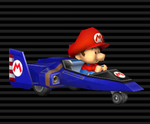
- The Blue Falcon kart is a reference to the vehicle of the same name in the F-Zero series, driven by Captain Falcon.
Mario Kart 8
- Two crossover downloadable content packs have been announced: The Legend of Zelda × Mario Kart 8 (pack one) and Animal Crossing × Mario Kart 8 (pack two).
- Link appears as a playable character in pack one, while the Villager and Isabelle from the Animal Crossing series appear in pack two.
- Hyrule Circuit (based on The Legend of Zelda series), Mute City (from the F-Zero series) and Excitebike Arena (based on Excitebike) appear in pack one, while Animal Crossing (based on the Animal Crossing series), and Big Blue (also from F-Zero) appear in pack two.
- The Blue Falcon returns as a vehicle in pack one. Also included in pack one are the Master Cycle, Triforce Tires, and Hylian Kite, all themed after The Legend of Zelda. Pack two includes the Streetle, City Tripper, Leaf Tires, and Paper Glider, all based on Animal Crossing.
- On Mute City and Big Blue, the countdown and results music are those of the F-Zero series rather than those used on other courses. On Big Blue, reaching the final section of the course causes the announcer from F-Zero X to say, "Yeah! The final lap!" In addition, Animal Crossing uses the music played in The Roost for its results theme.
- The Mercedes-Benz GLA, W 25 Silver Arrow, and 300 SL Roadster appear as downloadable vehicles, and the GLA's tires also appear as a set of tires.
- In Toad Harbor, a statue of Princess Peach similar in appearance to the Statue of Liberty can be seen. Toad Harbor also has some similarities to the city of San Francisco, California.
- As of update 3.0, by scanning a compatible amiibo into the game, the player can receive Mii costumes based upon various Nintendo characters, including Kirby, Captain Falcon, Link, and Fox.
Super Mario Maker
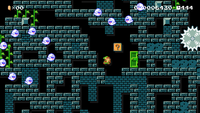
- Many of the Costume Mario costumes are based on characters from other non-Mario franchises.
- If the player places a spike in a Super Mario World-themed underwater level, the sprite used is based on that of a Sea Urchin from The Legend of Zelda: Link's Awakening, which in turn appears similar to the Gordos of the Kirby series.
